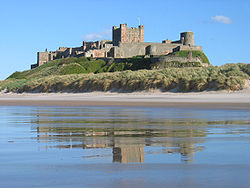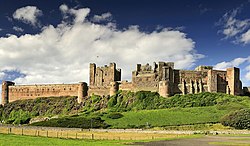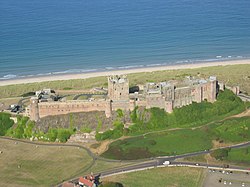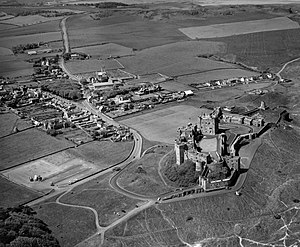Bamburgh Castle: Difference between revisions
Created page with '{{Infobox castle |name=Bamburgh Castle |county=Northumberland |picture=Bamburgh 2006 closeup.jpg |picture caption=Bamburgh Castle from the north east |os grid ref=NU183351 |owner…' |
m →top: ioe -> nhle, replaced: {{IoE|237848 → {{NHLE|1280155 |
||
| Line 7: | Line 7: | ||
|ownership=private | |ownership=private | ||
}} | }} | ||
'''Bamburgh Castle''' stands on the coast at [[Bamburgh]] in [[Northumberland]]. It is a Grade I listed building.<ref>{{ | '''Bamburgh Castle''' stands on the coast at [[Bamburgh]] in [[Northumberland]]. It is a Grade I listed building.<ref>{{NHLE|1280155|Bamburgh Castle}}</ref> | ||
==History== | ==History== | ||
Latest revision as of 21:54, 18 September 2019
| Bamburgh Castle | |
|
Northumberland | |
|---|---|
 Bamburgh Castle from the north east | |
| Location | |
| Grid reference: | NU183351 |
| History | |
| Information | |
| Owned by: | private |
Bamburgh Castle stands on the coast at Bamburgh in Northumberland. It is a Grade I listed building.[1]
History
 |
 |
| The south west face of Bamburgh Castle seen from ground level and above |
Built on a dolerite outcrop, the location was previously home to a fort of the native Britons and may have been the capital of the British kingdom of the region until 547, the year of the first written reference to the castle. In that year the citadel was captured by the Anglo-Saxon ruler, Ida, and became Ida's royal seat, and thus the capital of the Kingdom of the Bernicians. It was briefly retaken by the Britons from his son Hussa during the war of 590 before being relieved later the same year.
Over five hundred years later, the Normans built a new castle on the site, which forms the core of the present one. William II unsuccessfully besieged it in 1095 during a revolt supported by its owner, Robert de Mowbray, Earl of Northumbria. After Robert was captured, his wife continued the defence until coerced to surrender by the king's threat to blind her husband.
Bamburgh then became the property of the reigning English monarch. Henry II probably built the keep. As an important English outpost, the castle was the target of occasional raids from Scotland. In 1464 during the Wars of the Roses, it became the first castle in England to be defeated by artillery, at the end of a nine-month siege by Richard Neville, 16th Earl of Warwick.
The Forster family of Northumberland[2] provided the Crown with twelve successive governors of the castle for some 400 years until the Crown granted ownership to Sir John Forster. The family retained ownership until Sir William Forster (d. 1700) was posthumously declared bankrupt, and his estates, including the castle, were sold to Lord Crew, Bishop of Durham (husband of his sister Dorothy) under an Act of Parliament to settle the debts.
The castle deteriorated but was restored by various owners during the 18th and 19th centuries. It was finally bought by the Victorian industrialist William Armstrong, who completed the restoration.
During the Second World War, the Royal Navy corvette HMS Bamborough Castle was named after it.

The castle still belongs to the Armstrong family, and is opened to the public. It also hosts weddings and corporate events.
Vicinity features
About 9 miles to the south on a point of coastal land is the ancient fortress of Dunstanburgh Castle and about 5 miles to the north is Lindisfarne Castle on Holy Island.
Environmental factors
Air quality levels at Bamburgh Castle are excellent due to the absence of industrial sources in the region. Sound levels near the north-south road passing by Bamburgh Castle are in the range of 59 to 63 dBA in the daytime (Northumberland Sound Mapping Study, Northumberland, England, June 2003). Nearby are breeding colonies of Arctic and common terns on the inner Farne Islands, and of puffins, shags and razorbills on Staple Island.
Archaeology at Bamburgh
Since 1996, the Bamburgh Research Project has been investigating the archaeology and history of the Castle and Bamburgh area. The project has concentrated on the fortress site and the early mediæval burial ground at the Bowl Hole, to the south of the castle.
Archaeological excavations were started in the 1960s by Dr Brian Hope-Taylor, who discovered the gold plaque known as the Bamburgh Beast as well as the Bamburgh Sword.
The project runs a training dig for 10 weeks every summer for students to learn more about archaeological techniques and to further research into the Castle.
Armstrong and Aviation Artefacts Museum
The castle's laundry rooms feature the Armstrong and Aviation Artefacts Museum, with exhibits about Victorian industrialist William Armstrong and Armstrong Whitworth, the manufacturing company he founded. Displays include engines, artillery and weaponry, and aviation artefacts from two world wars.
Bamburgh Castle in film, television and books
The castle's raw, remote, romantic air has inspired many a filmmaker, and it has been used as a film location since the 1920s, featuring in films including:
- Huntingtower (1927)
- A Connecticut Yankee in King Arthur's Court (1949)
- Ivanhoe (1952)
- El Cid (1961)
- Becket (1964)
- Mary, Queen of Scots (1971)
- The Devils (1971)
- Elizabeth (1998)
- Robin of Sherwood (1984–86)
- Elizabeth (1998)
- Revelation (2001)
- Robin Hood (2010)
Time Team, the Channel 4 series, had a dig here in 2011.
In the Saxon Tales series of books by Bernard Cornwell, the main character is Uhtred of Bebbanburg (the old Saxon name of Bamburgh Castle)
Outside links
| ("Wikimedia Commons" has material about Bamburgh Castle) |
References
- ↑ National Heritage List 1280155: Bamburgh Castle
- ↑ The History and Antiquities of North Durham Rev James Raine MA (1840) pp306-10 History and pedigree of Forster family
- Glen Lyndon Dodds, (Albion Press, 2002), Historic Sites of Northumberland & Newcastle upon Tyne, pp 33–39
- David Ford Nash, "Early British Kingdoms"
- Fry, Plantagenet Somerset (1980). The David & Charles Book of Castles. Newton Abbot: David & Charles. pp. 182–183. ISBN 0-7153-7976-3.
